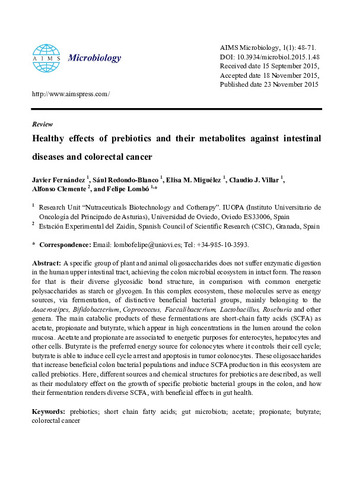Healthy effects of prebiotics and their metabolites against intestinal diseases and colorectal cancer
Palabra(s) clave:
Prebiotics
Short chain fatty acids
Gut microbiota
Acetate
Fecha de publicación:
Versión del editor:
Citación:
Descripción física:
Resumen:
A specific group of plant and animal oligosaccharides does not suffer enzymatic digestion in the human upper intestinal tract, achieving the colon microbial ecosystem in intact form. The reason for that is their diverse glycosidic bond structure, in comparison with common energetic polysaccharides as starch or glycogen. In this complex ecosystem, these molecules serve as energy sources, via fermentation, of distinctive beneficial bacterial groups, mainly belonging to the Anaerostipes, Bifidobacterium, Coprococcus, Faecalibacterium, Lactobacillus, Roseburia and other genera. The main catabolic products of these fermentations are short-chain fatty acids (SCFA) as acetate, propionate and butyrate, which appear in high concentrations in the lumen around the colon mucosa. Acetate and propionate are associated to energetic purposes for enterocytes, hepatocytes and other cells. Butyrate is the preferred energy source for colonocytes where it controls their cell cycle; butyrate is able to induce cell cycle arrest and apoptosis in tumor colonocytes. These oligosaccharides that increase beneficial colon bacterial populations and induce SCFA production in this ecosystem are called prebiotics. Here, different sources and chemical structures for prebiotics are described, as well as their modulatory effect on the growth of specific probiotic bacterial groups in the colon, and how their fermentation renders diverse SCFA, with beneficial effects in gut health
A specific group of plant and animal oligosaccharides does not suffer enzymatic digestion in the human upper intestinal tract, achieving the colon microbial ecosystem in intact form. The reason for that is their diverse glycosidic bond structure, in comparison with common energetic polysaccharides as starch or glycogen. In this complex ecosystem, these molecules serve as energy sources, via fermentation, of distinctive beneficial bacterial groups, mainly belonging to the Anaerostipes, Bifidobacterium, Coprococcus, Faecalibacterium, Lactobacillus, Roseburia and other genera. The main catabolic products of these fermentations are short-chain fatty acids (SCFA) as acetate, propionate and butyrate, which appear in high concentrations in the lumen around the colon mucosa. Acetate and propionate are associated to energetic purposes for enterocytes, hepatocytes and other cells. Butyrate is the preferred energy source for colonocytes where it controls their cell cycle; butyrate is able to induce cell cycle arrest and apoptosis in tumor colonocytes. These oligosaccharides that increase beneficial colon bacterial populations and induce SCFA production in this ecosystem are called prebiotics. Here, different sources and chemical structures for prebiotics are described, as well as their modulatory effect on the growth of specific probiotic bacterial groups in the colon, and how their fermentation renders diverse SCFA, with beneficial effects in gut health
ISSN:
Patrocinado por:
AC acknowledges support by Junta de Andalucía (AGR2011-7626) and CSIC (i-link0827). FL wishes to thank MINECO (Ministerio de Economía y Competitividad, Grant MINECO-14-RTC-2014-1525-2) and CDTI (Centro para el Desarrollo Tecnológico e Industrial, Grants IDI-20120896 and IDI-20120897) for financial support to JF. We also thank European Union H2020 Program (Grant UE-15-NOMORFILM-634588) for financial support to SRB.
Colecciones
- Artículos [37541]
- Biología Funcional [807]
- Investigaciones y Documentos OpenAIRE [8416]
Ficheros en el ítem





